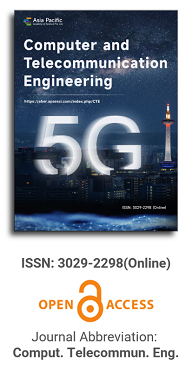
CORE: Counteracting overwhelming requests effectively—A method for interest flooding attack mitigation in NDNoT
Vol 2, Issue 2, 2024
Download PDF
Abstract
The Named Data Network (NDN) is a promising architecture for the near future. NDN communicates by naming data, unlike IP-based Internet architecture. Architectural understandability, ease of use, security, content presentation, and simplicity of data exchange logic make this architecture preferable. The NDNoT approach, which recently combines IoT and NDN, enables Internet of Things applications using NDN naming conventions and basic data structure. However, increasing technological applications bring security vulnerabilities. In this study, we propose a new method called CORE that will secure the intended data transfer. The presented CORE mechanism was developed as a countermeasure against the Interest Flooding attack, one of the NDN security attacks. Tests were carried out in the Cooja simulation environment using three different topology scenarios. CORE’s performance metrics were evaluated based on success rate, average delay, and interest traffic. The results showed that when the CORE mechanism was active, there was an improvement in the success rate and average delay. In terms of interest traffic, at least a 70% success rate was achieved compared to scenarios in which the CORE mechanism was not operated.
Keywords
References
- Arjunwadkar DP. Introduction of NDN with Comparison to Current Internet Architecture based on TCP/IP. International Journal of Computer Applications. 2014; 105(5): 31-35. doi: 10.5120/18376-9536
- Ahlgren B, Dannewitz C, Imbrenda C, et al. A survey of information-centric networking. IEEE Communications Magazine. 2012; 50(7): 26-36. doi: 10.1109/mcom.2012.6231276
- Zhang L, Afanasyev A, Burke J, et al. Named data networking. ACM SIGCOMM Computer Communication Review. 2014; 44(3): 66-73. doi: 10.1145/2656877.2656887
- Passarella A. A survey on content-centric technologies for the current Internet: CDN and P2P solutions. Computer Communications. 2012; 35(1): 1-32. doi: 10.1016/j.comcom.2011.10.005
- Atzori L, Iera A, Morabito G. The Internet of Things: A survey. Computer Networks. 2010; 54(15): 2787-2805. doi: 10.1016/j.comnet.2010.05.010
- Asghari P, Rahmani AM, Javadi HHS. Internet of Things applications: A systematic review. Computer Networks. 2019; 148: 241-261. doi: 10.1016/j.comnet.2018.12.008
- Aggarwal CC, ed. Managing and Mining Sensor Data. Springer US; 2013. doi: 10.1007/978-1-4614-6309-2
- Shang W, Bannis A, Liang T, et al. Named Data Networking of Things (Invited Paper). In: Proceedings of the 2016 IEEE First International Conference on Internet-of-Things Design and Implementation (IoTDI); 4-8 April 2016; Berlin, Germany. pp. 117-128. doi: 10.1109/iotdi.2015.44
- Zhang Z, Lu E, Li Y, et al. NDNoT: A framework for named data network of things. In: Proceedings of the 5th ACM Conference on Information-Centric Networking; 21-23 September 2018; Boston, Massachusetts, USA. pp. 200-201. doi: 10.1145/3267955.3269019
- Aboodi A, Wan TC, Sodhy GC. Survey on the Incorporation of NDN/CCN in IoT. IEEE Access. 2019; 7: 71827-71858. doi: 10.1109/access.2019.2919534
- Rai S, Dhakal D. A Survey on Detection and Mitigation of İnterest Flooding Attack İn Named Data Networking. Springer; 2018.
- Hidouri A, Hajlaoui N, Touati H, et al. A Survey on Security Attacks and Intrusion Detection Mechanisms in Named Data Networking. Computers. 2022; 11(12): 186. doi: 10.3390/computers11120186
- Afanasyev A, Mahadevan P, Moiseenko I, et al. Interest flooding attack and countermeasures in named data networking. In: Proceedings of the 2013 IFIP Networking Conference; 22-24 May 2013; Brooklyn, NY, USA. pp. 1-9.
- Lee RT, Leau YB, Park YJ, et al. A Survey of Interest Flooding Attack in Named-Data Networking: Taxonomy, Performance and Future Research Challenges. IETE Technical Review. 2021; 39(5): 1027-1045. doi: 10.1080/02564602.2021.1957029
- Saxena D, Raychoudhury V, Suri N, et al. Named Data Networking: A survey. Computer Science Review. 2016; 19: 15-55. doi: 10.1016/j.cosrev.2016.01.001
- Feng B, Zhou H, Xu Q. Mobility support in Named Data Networking: a survey. EURASIP Journal on Wireless Communications and Networking. 2016; 2016(1). doi: 10.1186/s13638-016-0715-0
- Bilgili S, Demir AK. A Named Data Networking Stack for Contiki NG OS. In: Proceedings of the 2022 2nd International Conference on Innovative Research in Applied Science, Engineering and Technology (IRASET); 3-4 March 2022. Meknes, Morocco. pp. 1-5. doi: 10.1109/iraset52964.2022.9738034
- Djama A, Djamaa B, Senouci MR. Information-Centric Networking solutions for the Internet of Things: A systematic mapping review. Computer Communications. 2020; 159: 37-59. doi: 10.1016/j.comcom.2020.05.003
- Shannigrahi S, Fan C, Partridge C. What’s in a Name?: Naming Big Science Data in Named Data Networking. In: Proceedings of the 7th ACM Conference on Information-Centric Networking; 29 September-1 October 2020; Online Conference. pp. 12-23. doi: 10.1145/3405656.3418717
- Nurhayati A, Mayasari R, Ahdan S, et al. Naming Scheme on Named Data Networking: A Survey. In: Proceedings of the 2022 8th International Conference on Wireless and Telematics (ICWT); 21-22 July 2022; Yogyakarta, Indonesia. pp. 1-5. doi: 10.1109/icwt55831.2022.9935350
- Oikonomou G, Duquennoy S, Elsts A, et al. The Contiki-NG open source operating system for next generation IoT devices. SoftwareX. 2022; 18: 101089. doi: 10.1016/j.softx.2022.101089
- Osterlind F, Dunkels A, Eriksson J, et al. Cross-Level Sensor Network Simulation with COOJA. In: Proceedings of the 2006 31st IEEE Conference on Local Computer Networks; 14-16 November 2006; Tampa, FL, USA. pp. 641-648. doi: 10.1109/lcn.2006.322172
Supporting Agencies
Copyright (c) 2024 Sedat Bilgili, Gökçe Ertit, Alper Kamil Demir
License URL: https://creativecommons.org/licenses/by/4.0/

Prof. Maode Ma
Qatar University, Qatar
The field of computer and telecommunications engineering is rapidly advancing, with the following being some of the latest developments.
more
We are pleased to congratulate the first anniversiry of the journal of Computer and Telecommunication Engineering (CTE).
more
Owing to the tireless dedication of the editor-in-chief, editorial board members, and the in-house editorial team, we are proud to announce the successful online launch of the first issue of Computer and Telecommunication Engineering.
Asia Pacific Academy of Science Pte. Ltd. (APACSCI) specializes in international journal publishing. APACSCI adopts the open access publishing model and provides an important communication bridge for academic groups whose interest fields include engineering, technology, medicine, computer, mathematics, agriculture and forestry, and environment.


.jpg)

.jpg)
